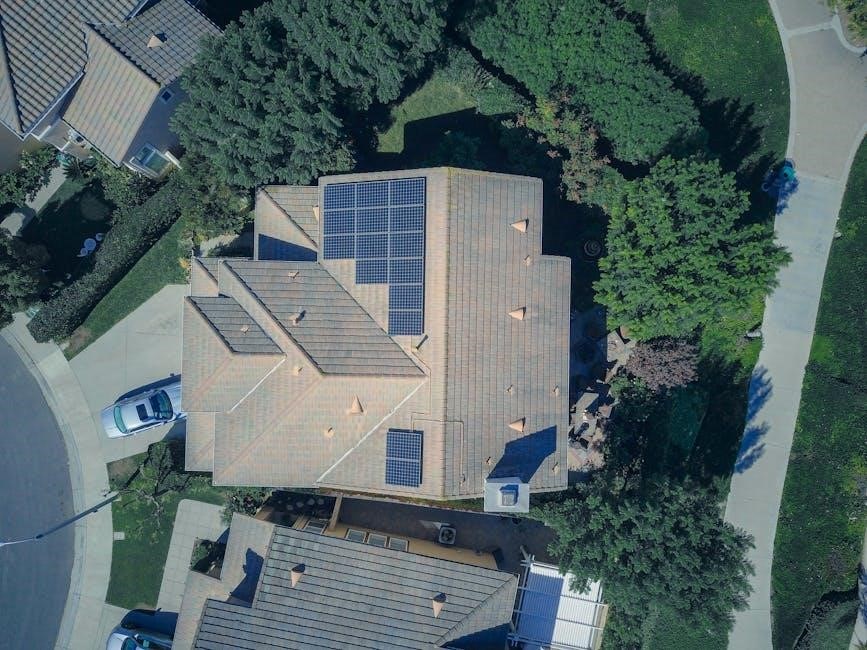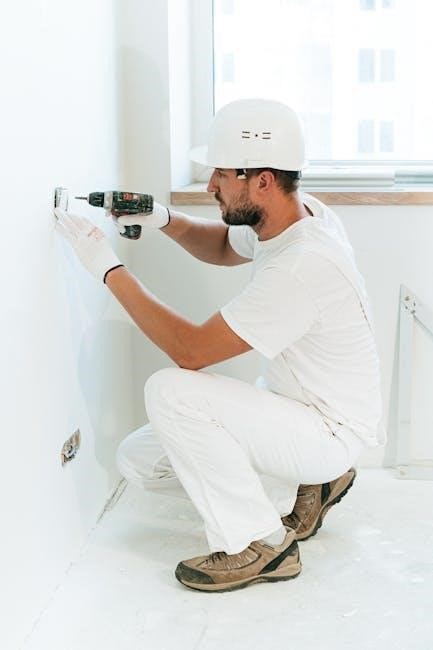
viper 5706v installation guide pdf
This guide provides detailed instructions for installing the Viper 5706V car alarm and remote start system. Ensure proper installation for optimal performance and security.
1.1 Overview of the Viper 5706V System
The Viper 5706V is a state-of-the-art car security and remote start system designed to protect your vehicle and enhance convenience. It features advanced security alarms, remote start functionality, and user-friendly controls. With the Responder LC remote, you can arm/disarm the system, start your engine remotely, and receive real-time status updates. The system is equipped with cutting-edge technology, ensuring reliability and ease of use. The manual provides comprehensive guidance for installation, operation, and troubleshooting, making it essential for both DIY enthusiasts and professionals. Proper installation ensures all features function seamlessly, providing optimal security and performance for your vehicle.
Proper installation of the Viper 5706V is crucial for ensuring system reliability, performance, and vehicle safety. Improper wiring or setup can lead to malfunctions, reduced security, or even damage to your car’s electrical systems. Following the installation guide carefully minimizes risks and ensures all features operate as intended. Correct installation also prevents false alarms, ensures remote start functionality works safely, and maintains the overall integrity of your vehicle’s electronics. Additionally, proper installation is essential for compliance with manufacturer recommendations and local regulations. Always refer to the official manual for specific instructions tailored to your system to guarantee a seamless and secure setup. Professional installation by an authorized dealer is highly recommended if you lack experience with such systems. Before starting, ensure you have the Viper 5706V manual, necessary tools, and a clear understanding of wiring diagrams to proceed effectively. The Viper 5706V installation manual is essential for a successful setup. It can be downloaded as a PDF from the official Directed Electronics website or accessed through authorized dealers. This comprehensive guide includes detailed diagrams, wiring instructions, and troubleshooting tips. Ensure you have the latest version to avoid outdated information. Printing the manual or saving it digitally is recommended for easy reference during the installation process. Additionally, online forums and technical support resources are available for further assistance. Always verify the source to ensure authenticity and accuracy. By having the manual handy, you can follow step-by-step instructions and avoid common installation pitfalls. Proper preparation is key to ensuring your Viper 5706V system functions optimally. To install the Viper 5706V system, you’ll need specific tools and materials. Essential items include a multimeter for wiring tests, a wiring harness, and connectors for secure connections. A screwdriver set, pliers, and a soldering iron may also be required for custom wiring setups; Additionally, ensure you have the provided installation harness and any optional accessories like relays or fuses; Consult the manual for a detailed list of materials specific to your vehicle’s make and model. Having all tools and materials ready beforehand will streamline the installation process and minimize delays. Proper preparation ensures a safe and efficient setup of your Viper 5706V system. The wiring diagram is a critical component of the Viper 5706V installation process. It provides a visual representation of the system’s connections, ensuring accurate wiring between the control module, sensors, and vehicle electronics. Each wire is color-coded and labeled to indicate its function, such as power, ground, ignition, and alarm triggers. Familiarize yourself with the diagram to identify connections specific to your vehicle, like door locks, starters, and siren outputs. Properly matching the wires according to the diagram prevents system malfunctions and safety issues. If uncertain, consult the manual or seek professional assistance to ensure all connections are correct. A well-understood wiring diagram is essential for a successful and trouble-free installation of your Viper 5706V system. Always double-check connections before powering up the system. The Viper 5706V installation involves mounting the control module, connecting wires, and installing sensors. Follow the guide to ensure all components are properly connected and functioning correctly. Mounting the control module is a critical step in the Viper 5706V installation. Choose a secure, dry location, such as under the dashboard, ensuring accessibility for wiring connections. Use the provided mounting hardware to secure the module firmly. Connect the necessary wires according to the wiring diagram in the manual. Ensure the module is level and protected from moisture or extreme temperatures. After installation, test the system to confirm proper functionality. Always refer to the installation guide for specific instructions and safety precautions to avoid damage or malfunctions. Proper mounting ensures reliable performance and longevity of your Viper 5706V system. Connect the battery wire to the constant power source of your vehicle’s battery, ensuring it remains active at all times. The ignition wire should be linked to a circuit that only powers on when the key is in the ‘on’ position. Use a voltage tester to verify the correct wiring connections before proceeding. Secure all wires neatly and avoid any potential sources of interference. Proper connection of these wires ensures the system functions correctly and safely. Always refer to the wiring diagram in the installation guide for specific instructions tailored to your vehicle. If issues arise, consult the troubleshooting section or contact an authorized technician. Accurate connections are essential for the reliable operation of the Viper 5706V system. Proper installation of door lock and alarm sensors is crucial for the Viper 5706V system to function effectively. Begin by mounting the door lock sensor near the vehicle’s door lock mechanism, ensuring it aligns with the lock’s movement. Connect the sensor wires to the control module, following the wiring diagram provided in the installation guide. For alarm sensors, install them in areas prone to tampering, such as doors, hood, and trunk. Use double-sided tape or screws to secure them firmly. After installation, test each sensor to ensure it triggers the alarm when activated. Verify that the door locks respond correctly to remote commands. If any issues arise, consult the troubleshooting guide or contact a professional installer. Accurate placement and wiring of these components ensure reliable security and functionality. The remote start setup for the Viper 5706V allows you to start your vehicle from a distance. Begin by accessing the programming mode in the control module. Press and hold the remote start button until the LED flashes. Next, synchronize the remote with the system by turning the ignition to the “ON” position and pressing the remote start button three times. The system will confirm synchronization with a beep or LED flash. Test the remote start by pressing the button and ensuring the vehicle starts. For safety, the system may require the brake pedal to be pressed before starting. If issues arise, consult the troubleshooting guide or contact a professional installer. Proper setup ensures reliable remote start functionality and vehicle security. Always follow the installation guide for accurate configuration. Programming the remote start feature on the Viper 5706V system ensures seamless operation. Start by accessing the system’s programming mode. With the ignition in the “OFF” position, press and hold the remote start button until the LED on the control module flashes. This indicates the system is ready to accept commands. Next, turn the ignition to the “ON” position without starting the engine. Press the remote start button three times in quick succession. The system will confirm successful programming with a series of beeps or LED flashes. If the vehicle has a manual transmission, ensure the clutch pedal is pressed during this process to avoid accidental starting. Once programmed, test the remote start by pressing the button and verifying that the vehicle starts. For additional vehicles or remotes, repeat the process. Always refer to the installation guide for specific instructions tailored to your vehicle’s make and model. Proper programming is crucial for reliable remote start functionality. Testing the remote start functionality ensures proper operation after installation. Begin by exiting the vehicle and locking the doors using the remote. Press the remote start button to initiate the process. The system should activate the starter motor, and the engine should crank and start. Allow the engine to run for a few seconds to confirm smooth operation. Check that the vehicle’s accessories, such as lights or wipers, do not activate during the remote start cycle; If the vehicle is equipped with a manual transmission, ensure the clutch pedal is pressed during testing to prevent accidental movement. If the vehicle starts in gear, immediately shut down the remote start and consult the installation guide or a professional. Repeat the test multiple times to confirm consistent performance. This step ensures the remote start feature functions safely and reliably under various conditions. Always follow the manufacturer’s guidelines for testing to avoid potential issues. This section covers verifying system functionality and addressing common issues. Test all features, including the alarm, remote start, and sensors, to ensure proper operation. Consult the manual for troubleshooting guides or contact Directed support for assistance. Testing the alarm functions ensures your Viper 5706V system operates correctly. Start by triggering the alarm using a door or hood sensor to verify the siren activates. Check the LED status and ensure all zones are monitored. Test the shock sensor by gently tapping the vehicle to see if the alarm responds. Also, ensure the remote arming and disarming features work seamlessly. If the system fails to respond, review wiring connections and sensor adjustments. If issues persist, refer to the troubleshooting section or contact Directed support for further assistance. Proper testing ensures your vehicle’s security is reliable and effective. Common issues during the Viper 5706V installation may include remote start malfunctions, sensor inaccuracies, or wiring problems. First, check the remote start functionality by ensuring the vehicle is in park and the brake pedal is pressed. If the system fails to start, verify the neutral safety wire connection. For sensor issues, inspect door and hood triggers for proper alignment and cleanliness. Wiring problems can often be resolved by reviewing connections in the main harness. If the LED status indicator flashes erratically, consult the user manual for specific fault codes. Persistent issues may require advanced troubleshooting, such as testing the tachometer or reprogramming the remote. Refer to the detailed troubleshooting guide in the Viper 5706V manual or contact Directed support for professional assistance. Always ensure safety when resolving electrical or sensor-related problems.
Ensure compliance with local regulations and safety standards when installing the Viper 5706V. Always follow proper installation procedures to avoid electrical hazards and system malfunctions. Before installing the Viper 5706V, ensure compliance with all local laws and regulations regarding car alarm and remote start systems. Certain features may be restricted in specific areas, so it’s crucial to verify legal requirements. Directed Electronics, the manufacturer, recommends consulting local authorities to avoid any legal issues. Additionally, the system must comply with FCC regulations to prevent interference with other electronic devices. Proper installation by an authorized dealer is highly recommended to ensure adherence to all legal standards. Failure to comply may result in fines or system malfunction. Always refer to the installation guide for specific instructions and guidelines to maintain legal and operational integrity. Safety is paramount when installing and using the Viper 5706V system. Always follow the manufacturer’s guidelines to prevent potential hazards. Ensure the system is installed correctly to avoid electrical malfunctions or fire risks. Keep the remote start feature away from children to prevent accidental activation. During installation, disconnect the battery to avoid electrical shocks. Test the system thoroughly after installation to ensure all features operate safely. Regularly inspect wiring and connections to maintain reliability. In case of any issues, consult an authorized Directed dealer for assistance. Adhering to safety protocols ensures the system functions correctly and protects both you and your vehicle. Refer to the Viper 5706V installation guide for detailed safety precautions and best practices. Complete a thorough inspection of the Viper 5706V system to ensure all components function correctly. Verify remote start, alarm, and sensor operations. Consult the manual for any final adjustments or troubleshooting. After completing the installation, perform a final inspection to ensure all components of the Viper 5706V system are securely connected and functioning properly. Check the control module, wiring, and sensors for any signs of damage or loose connections. Test the remote start feature to confirm it operates correctly, ensuring the vehicle starts and stops as expected. Verify that the alarm system responds to triggers, such as door openings or impacts, and that the LED status indicator is functioning. Review the manual for specific inspection steps and troubleshooting tips to address any issues. This final check ensures your system is reliable, secure, and ready for daily use. If you are not confident in your ability to install the Viper 5706V system, consider seeking assistance from a professional installer. Directed Electronics recommends that installation be performed by an authorized dealer due to the system’s complexity. A professional can ensure that all components, including the remote start and alarm features, are installed correctly and function as intended. They will also handle any wiring and programming requirements, reducing the risk of errors or damage to your vehicle’s electrical system. Additionally, a professional installer can provide guidance on advanced features and ensure compliance with local regulations. For complex setups or if you encounter issues, consult an authorized Directed dealer or contact their support team at 1-800-753-0600 for assistance.1.2 Importance of Proper Installation

Pre-Installation Requirements
2.1 Obtaining the Installation Manual
2.2 Tools and Materials Needed
2.3 Understanding the Wiring Diagram

Installation Process
3.1 Mounting the Control Module

3.2 Connecting the Battery and Ignition Wires
3.3 Installing Door Lock and Alarm Sensors

Remote Start Setup
4.1 Programming the Remote Start Feature
4.2 Testing the Remote Start Functionality

System Testing and Troubleshooting

5.1 Testing Alarm Functions
5.2 Troubleshooting Common Issues

Legal and Safety Considerations

6.1 Compliance with Local Regulations
6.2 Ensuring System Safety

7.1 Final System Inspection
7.2 Considering Professional Installation